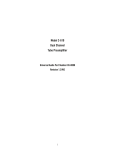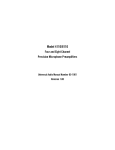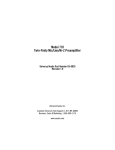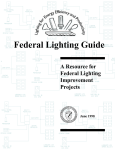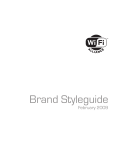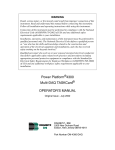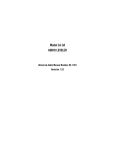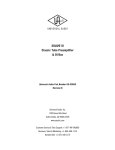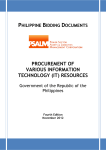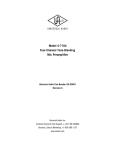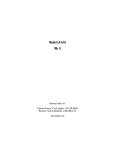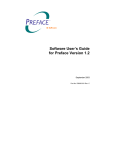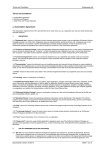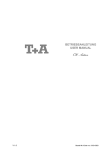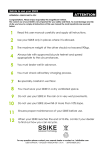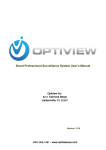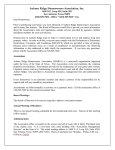Download Memorandum of Understanding between The United States
Transcript
This Version of the Copier Memorandum of Understanding Incorporates Copier Amendments 1 and 2
Memorandum of Understanding between
The United States Environmental Protection Agency
and
Company Name
I. Common Agreements and Principles
A. This is a voluntary agreement between Company Name
("EPA ENERGY
®
STAR Partner" or "Partner") and the United States Environmental Protection Agency (EPA), by
which Company Name
joins the EPA ENERGY STAR® Program. The
terms of this MOU shall apply to copiers sold by Partner under its own brand name(s).
B. EPA ENERGY STAR Partner and EPA agree that the primary purpose of the EPA ENERGY
STAR Program is to promote the manufacturing and marketing of energy-efficient equipment,
thereby potentially reducing combustion-related pollution.
C. EPA ENERGY STAR Partner and EPA agree that the use of energy-efficient equipment may
also increase profits and competitiveness.
D. EPA ENERGY STAR Partner and EPA agree that the EPA ENERGY STAR Program may also
improve or enhance equipment's useful lifetime, customer satisfaction, and overall product
quality.
E. EPA ENERGY STAR Partner and EPA agree that publicizing the EPA ENERGY STAR Program
is important to demonstrate the following: the concern of Partner for the environment, the
vitality of the free enterprise system in reducing costs, and the capability of voluntary programs
to achieve environmental goals.
F. EPA ENERGY STAR Partner and EPA agree that maintaining public confidence in the EPA
ENERGY STAR Program is critical to achieving the shared goals of Partner and EPA.
G. EPA ENERGY STAR Partner and EPA agree that membership in the EPA ENERGY STAR
Program is essential to the cooperative effort to achieve the shared goals stated above.
II. Definitions
A. Copier: A commercial reprographic imaging unit whose sole function is the production of
duplicates from a graphic hard copy original. A copier must include a marking system, an
imaging system, and a paper handling module. All black and white plain paper technologies are
covered under this MOU, though the intent is to focus on widely-used standard copier equipment
such as light lens copiers. The specifications outlined below apply to standard-sized copiers
designed to handle A4 or 8.5" x 11" paper and large format copiers designed to handle A2 or 17"
x 22" paper or larger.
Copier MOU — Version 2.0
EPA added Amendments 1 and 2 to MOU — Version 1.0 in November 1999
This Version of the Copier Memorandum of Understanding Incorporates Copier Amendments 1 and 2
B. Copier Speed: Copies per minute (cpm) measures the reproduction speed of the copier. One
copy is defined as one 8.5" x 11" or A4-sized page. Double-sided copies are considered as two
images and therefore two copies even though they are copied onto one piece of paper. For all
copier models sold in the U.S. market, measurement of copier speed shall be based on 8.5" x 11"
letter-sized paper. For copiers sold in markets other than the U.S., copier speed shall be based on
either 8.5" x 11" or A4-sized paper, depending on which is the standard in a particular market.
For large format copiers designed to handle primarily A2 or 17" x 22" paper or larger, the copier
speed measured as A2- or A0-sized copies per minute shall be converted into A4-sized copier
speeds as follows: (a) One A2 copy per minute is equivalent to four A4 copies per minute, and
(b) One A0 copy per minute is equivalent to 16 A4 copies per minute.
Copiers qualified under this MOU shall be divided into five categories: low speed standard-sized
copiers, medium speed standard-sized copiers, high speed standard-sized copiers, low speed
large format copiers, and medium and high speed large format copiers.
1. Low Speed Standard-Sized Copiers: Copiers with an engine speed for producing multiple
images of 20 copies per minute or less.
2. Medium Speed Standard-Sized Copiers: Copiers with an engine speed for producing multiple
images of greater than 20 and less than or equal to 44 copies per minute.
3. High Speed Standard-Sized Copiers: Copiers with an engine speed for producing multiple
images of greater than 44 copies per minute.
4. Low Speed Large Format Copiers: Copiers with an engine speed for producing multiple
images of 40 copies per minute or less (expressed as A4-sized copies per minute).
5. Medium and High Speed Large Format Copiers: Copiers with an engine speed for producing
multiple images of greater than 40 copies per minute (expressed as A4-sized copies per minute).
C. Base Unit: For a given engine speed, the base unit is defined as the most basic version of a
copier that is actually sold as a fully operational model. The base unit is typically designed and
shipped in a single piece, and does not include any external power-consuming accessories that
may be sold separately.
D. Accessory: A piece of additional equipment that is not necessary for the standard operation
of the base unit, but that may be added before or after shipping in order to enhance or change
copier performance. An accessory may be sold separately under its own model number, or sold
with a base unit as part of a copier package or configuration. Examples of accessories include:
sorters, large capacity paper feeders, etc. It is assumed that the addition of an accessory,
irrespective of its own power consumption, will not substantially increase (more than 10 percent)
the off mode power consumption of the base unit. Any accessories shall not impede the normal
Copier MOU — Version 2.0
EPA added Amendments 1 and 2 to MOU — Version 1.0 in November 1999
This Version of the Copier Memorandum of Understanding Incorporates Copier Amendments 1 and 2
operation of the auto-off and low-power features.
E. Copier Model: For purposes of this MOU, a copier model is defined as a base unit and one or
more specific accessories that are advertised and sold to consumers under a single model number.
When advertised and sold to consumers without any additional accessories, a base unit is also
considered a copier model.
F. Low-power Mode: For purposes of this MOU, the low-power mode is the lowest power state
the copier can automatically enter within some period of copier inactivity, without actually
turning off. The copier enters this mode within a specified period of time after the last copy was
made. For purposes of determining the power consumption in this low-power mode, the ENERGY
STAR partner may choose to measure the lowest of either the energy-saver mode or the standby
mode.
G. Energy-Saver Mode: The condition that exists when the machine is not making copies, has
previously reached operating conditions but is consuming less power than when the machine is in
stand-by mode. When the copier is in this mode, there may be some delay before the copier will
be capable of making the next copy.
H. Standby Mode: The condition that exists when the machine is not making copies, has
reached operating conditions and is ready to make a copy, but has not yet entered into
energy-saver mode. When the copier is in this mode, there will be virtually no delay before the
copier is capable of making the next copy.
I. Off Mode: For purposes of this MOU, the off mode is defined as the condition that exists when
the copier is connected to an appropriate electrical source, and has been recently shut off via the
auto-off feature.1 When measuring power in this mode, control equipment for remote servicing
may be excluded.
J. Auto-off Feature: For purposes of this MOU, the auto-off feature is defined as the ability of
the copier to automatically shut itself off within a specified period of time after the last copy was
made. The copier shall automatically enter its off mode after execution of this feature.
K. Plug-In Mode: The condition that exists when the machine is connected to an appropriate
electrical source and is not turned on. To turn the copier on, the user typically needs to manually
restart the copier via the on/off switch.
1
Section IV.B. of this MOU contains maximum power consumption targets for the off mode. EPA expects
that most companies will meet these off mode power consumption targets by incorporating an auto-off feature in the
copier. However, it is possible and allowable under this MOU for a manufacturer to utilize a low-power mode,
rather than an auto-off feature if the low-power mode power consumption is equal to or less than the off mode power
consumption targets contained in this MOU. (See EPA’s Testing Guidelines for copiers for more information on this
issue.)
Copier MOU — Version 2.0
EPA added Amendments 1 and 2 to MOU — Version 1.0 in November 1999
This Version of the Copier Memorandum of Understanding Incorporates Copier Amendments 1 and 2
L. Default Times: The time period set by the Partner prior to shipping that determines when the
copier will enter its various modes, i.e., the low-power mode, the off mode, etc. Both the off
mode default times and the low-power mode default times shall be measured from the time the
last copy was made.
M. Recovery Time: The amount of time needed to bring the copier from the low-power mode to
the standby mode.
N. Automatic Duplex Mode: The mode in which the copier automatically places images on both
sides of a copy sheet, by automatically sending both the copy sheet and the graphic original
through the copier model. Examples of this are one-sided to two-sided copying, or two-sided to
two-sided copying. For purposes of this MOU, a copier model is considered to have an
automatic duplex mode only if the copier model includes all accessories needed to satisfy the
above conditions, i.e., an automatic document feeder and accessories for automatic duplexing
capabilities.
O. Weekly Timer: An internal device that turns a copier on and off at predetermined times each
business day. When programming a timer, the customer shall be able to distinguish between
business days and weekends/holidays (i.e., a timer shall not turn on a copier on Saturday and
Sunday mornings if employees are not normally in the office on weekends). The customer shall
also have the ability to disable the timer. Weekly timers are optional features, and therefore are
not required on ENERGY STAR compliant copiers. If included in copier models, weekly timers
shall not conflict with the functioning of the low-power and auto-off features.
III. Entry into Force and Duration
A. This MOU enters into force when signed by both EPA and Partner.
B. Both parties agree to the following schedule for implementing the specifications contained in
this MOU.
1. The first tier of the program shall commence on July 1, 1995 and conclude on June 30, 1997.
Partners can qualify copier models for Tier 1 starting July 1, 1995.
2. The second tier of the program shall commence on July 1, 1997. The criteria for Tier 2 shall
apply to copier models that Partner begins to ship after June 30, 1997. Tier 1 models may
continue to bear the ENERGY STAR logo until the models are phased out of the market (i.e., the
new specifications will not apply retroactively to previously qualified products). Models that
Partner begins to ship on or after July 1, 1997 must be qualified under the new specifications
outlined in Table 2 of Section IV.B., below, though Partner may choose, at its discretion, to
implement the new terms prior to this date.
3. The third tier of the program shall commence on July 1, 1999. The criteria for Tier 3 shall
Copier MOU — Version 2.0
EPA added Amendments 1 and 2 to MOU — Version 1.0 in November 1999
This Version of the Copier Memorandum of Understanding Incorporates Copier Amendments 1 and 2
apply to copier models that Partner begins to ship on or after July 1, 1999. Tier 2 LARGE
FORMAT COPIER models may continue to bear the ENERGY STAR logo until the models are
phased out of the market (i.e., the new specifications will not apply retroactively to previously
qualified products). LARGE FORMAT COPIER models that Partner begins to ship on or after
July 1, 1999 must be qualified under the new specifications outlined in Table 4 of Section IV.B.,
below, though Partner may choose, at its discretion, to implement the new terms prior to this
date.
C. The terms of this MOU shall remain in force until such time as EPA institutes new
specifications or discontinues the ENERGY STAR Program. Both parties agree that as
technologies and markets change, it may become desirable to change the technical specifications
included in this MOU in order to keep the ENERGY STAR Program responsive and to maintain its
integrity.
D. Both parties agree that this agreement can be terminated by EPA ENERGY STAR Partner or
EPA at any time, and for any reason, with no penalty. However, both parties agree that
termination for noncompliance would only occur in accordance with the procedures of Section
VII., below.
IV. EPA ENERGY STAR Partner's Responsibilities
A. EPA ENERGY STAR Partner agrees to appoint a responsible representative of the company as
liaison with EPA for the EPA ENERGY STAR Program and to notify EPA within one month of
any change in liaison responsibility. (See Attachment A.)
B. Product Qualification for the ENERGY STAR Logo
1. Technical Specifications
EPA ENERGY STAR Partner agrees to introduce one or more specific copier models that
meet the specifications outlined in Tables 1 through 4, below.
Table 1.
Tier 1 criteria for the ENERGY STAR Copier Program. (July 1, 1995.)
Copier Speed
(copies per minute)
Off Mode
(Watts)
Off Mode
Default Time
Automatic
Duplex Mode
0 < cpm < 20
<5
< 30 minutes
No
20 < cpm < 44
<40
< 60 minutes
Optional
44 < cpm
<40
< 90 minutes
Default
Copier MOU — Version 2.0
EPA added Amendments 1 and 2 to MOU — Version 1.0 in November 1999
This Version of the Copier Memorandum of Understanding Incorporates Copier Amendments 1 and 2
Table 2.
Tier 2 Criteria for the ENERGY STAR Copier Program. (July 1, 1997)
Copier Speed
(copies per
minute)
Low-Power
Mode2
(watts)
LowPower
Default
Time
Recovery Time
30 seconds
Off
Mode
(watts)
Off Mode
Default
Time
Automatic
Duplex
Mode
0 < cpm # 20
None
NA
NA
#5
# 30 min.
No
20 < cpm # 44
3.85 x cpm + 5
15 min.
Yes
# 15
# 60 min.
Optional
44 < cpm
3.85 x cpm + 5
15 min.
Recommended
# 20
# 90 min.
Optional
To qualify as ENERGY STAR compliant, copier models designed to handle primarily A2 or
17" x 22" paper or larger shall meet the specifications provided in Tables 3 and 4. All large
format copier speeds shall be measured with respect to the number of A4-sized copies that are
produced per minute, as described above.
Table 3.
Tier 2 Criteria for the ENERGY STAR Copier Program — LARGE FORMAT COPIERS
(effective until June 30, 1999)
Copier Speed
(copies per
minute)
Low-Power
Mode
(watts)
LowPower
Default
Time
Recovery
Time
30 seconds
Off
Mode
(watts)
Off Mode
Default
Time
Automatic
Duplex
Mode
0 < cpm # 40
NA
NA
NA
# 20
# 30 min.
No
40 < cpm
NA
NA
NA
# 40
# 90 min.
No
For Tier 2, Partner shall ship copier models with the default time for the low-power mode
set to the values stated in Tables 2 and 3 above. Partner shall set the default times for the autooff feature to the levels specified in Tables 1, 2, and 3 above. The default times for the off mode
and the low-power mode shall be measured from the time the last copy was made.
2
The formula for copier speeds of 20 < cpm should be read as 3.85 multiplied by the number of copies per
minute plus 5.0.
Copier MOU — Version 2.0
EPA added Amendments 1 and 2 to MOU — Version 1.0 in November 1999
This Version of the Copier Memorandum of Understanding Incorporates Copier Amendments 1 and 2
Table 4.
Tier 3 Criteria for the ENERGY STAR Copier Program — LARGE FORMAT COPIERS
(effective July 1, 1999)
Copier Speed
(copies per
minute)
Low-Power
Mode2
(watts)
LowPower
Default
Time
Recovery Time
30 Seconds
Off
Mode
(watts)
Off Mode
Default
Time
Automatic
Duplex
Mode
0 < cpm # 40
NA
NA
NA
# 10
# 30 min.
No
40 < cpm
3.85 x cpm +5
15 min.
Recommended
# 20
# 90 min.
No
For Tier 3, Partner shall ship copier models with the default time for the low-power mode
set at the values stated in Table 4. Partner shall set the default times for the auto-off feature to
the levels specified in Table 4 above. The default times for the off mode and the low-power
mode shall be measured from the time the last copy was made.
For all copier speeds where it is optional that the duplex mode be set as the default, if a
model is shipped with automatic duplexing capabilities, then it is recommended that duplexing
be set as the default mode. Partner may provide users with the ability to override this default
duplex mode for single-sided copies.
2. Product Qualification
a. Low Speed Copiers
Any base unit in this copier speed range satisfying the above criteria shall qualify for the
program. The ENERGY STAR logo may be applied directly to any qualifying base unit, regardless
of whether it is shipped with additional accessories. Any copier model that includes a qualified
base unit may be deemed an ENERGY STAR Copier model.
b. Medium Speed Copiers
The ENERGY STAR logo may be applied directly to any qualifying base unit, regardless of
whether it is shipped with additional accessories. Any copier model that includes any qualified
base unit may be deemed an ENERGY STAR Copier Model.
For Tier 2, it is recommended that high speed copier models may be able to recover from the low
power mode within 30 seconds or less. Declaration of the recovery time shall be placed in the
product literature. (See section IV.C.1.)
c. High Speed Standard-Sized Copiers and Medium and High Speed Large Format Copiers
The ENERGY STAR logo may be applied directly to any qualifying base unit, regardless of
whether it is shipped with additional accessories. Any copier model that includes any qualified
Copier MOU — Version 2.0
EPA added Amendments 1 and 2 to MOU — Version 1.0 in November 1999
This Version of the Copier Memorandum of Understanding Incorporates Copier Amendments 1 and 2
base unit may be deemed an ENERGY STAR compliant copier model.
For Tier 2, it is recommended that high speed standard-sized copier models be able to
recover from the low-power mode within 30 seconds or less. For Tier 3, it is recommended that
medium and high speed large format copier models be able to recover from the low-power mode
within 30 seconds or less. Declaration of the recovery time shall be placed in product literature.
(See Section IV.C.1 of the MOU.)
3. Exceptions and Clarifications
After shipping, Partner or its designated service representative shall not alter the copier
model in any way that will affect the copier's ability to meet the specifications outlined above.
Certain exceptions are allowed in changing the default times, the off mode specifications, and the
duplex mode. These exceptions are as follows:
a. Default Times
After shipping, the Partner, designated service representative, or customer may change
the default times for the low-power mode and/or the off mode, but only up to a factory-set
maximum of 240 minutes (i.e., the combined total of the default times shall not exceed 240
minutes).
b. Off Mode Power Consumption
In some cases, Partner may need to ship a copier model with the anti-humidity device
disconnected in order to meet off mode power requirements. If this situation leads to sizable
inconvenience for a specific customer, Partner (or the designated service representative) may
connect the anti humidity device. If Partner determines that in a certain geographical area there
are chronic reliability problems associated with high humidity levels, Partner may contact the
EPA program manager (as named in Attachment A) and discuss alternative solutions. For
example, EPA may allow Partner to connect the anti-humidity devices in copier models that are
shipped to a very humid geographical area.
c. Automatic Duplex Mode
In an individual case where the duplexing feature is causing a customer sizable
inconvenience due to their particular usage patterns, the Partner (or the designated service
representative) may disable this default mode at the customer's request.
d. Disabling the Auto-Off Feature
In an individual case where the auto-off feature is causing a customer sizable
inconvenience due to his/her particular usage patterns, the Partner, designated service
representative, or customer may disable this auto-off feature. If Partner chooses to design its
copier models to allow the customer to disable the auto-off feature, then the disable option shall
be accessed in a manner different from the time settings. (e.g., If a software menu provides off
mode delay times of 30, 60, 90, 120, and 240 minutes, then “disable” or “off” shall not be a
choice in this menu. It shall be a hidden (or less obvious) choice or included in a different
Copier MOU — Version 2.0
EPA added Amendments 1 and 2 to MOU — Version 1.0 in November 1999
This Version of the Copier Memorandum of Understanding Incorporates Copier Amendments 1 and 2
menu.)
C. Customer Education
1. Product Literature:
Partner shall provide general information to users regarding the ENERGY STAR features of
the copier model. This information might include a description of the ENERGY STAR Program, a
discussion of the savings associated with using the power-management features, the benefits of
duplex copying, and the method for changing the settings or default times. Partner may
determine the best manner through which to disseminate this general information to users.
Examples of acceptable approaches include: user's manual, special brochures included in the
shipping box, etc.
Partner shall also provide in the user’s manual and/or other collateral sales and marketing
materials three specific pieces of information regarding the auto-off feature. First, the economic
and environmental benefits of using the auto-off feature shall be addressed. Second, Partner
shall explain that the copier model is shipped with the auto-off feature enabled and clearly state
the default time. Third, Partner shall suggest how to determine the appropriate default time
(based on the user’s work pattern) and provide instructions for changing the time setting. In
addition, Partner may explain the process for disabling the auto-off feature (e.g., by providing
written instructions and/or by including a customer support telephone number), so long as the
benefits of the feature and instructions for extending the default time are discussed first.
In addition, Partner shall provide information on recommended types of recycled paper
that can best be used in a particular copier, including the amount of post-consumer content in the
paper.3 Partner shall include clear statements addressing the recovery time from the low-power
mode in both the user's manual and on data sheets. Brochures and advertisements shall be
worded to avoid misleading interpretations.
2. Logo Usage
To help consumers become familiar with the ENERGY STAR Copier Program, the Partner
shall place the ENERGY STAR logo onto qualified products, where practical.4 The Partner shall
also strive to include the ENERGY STAR logo in brochures, manuals, and advertisements, etc. for
qualified products
D. Measuring Power Consumption
3
The U.S. Government has specified a minimum of 20% post-consumer content for all paper purchased for
government use. Partner may wish to include information on this or other types of recycled paper.
4
The ENERGY STAR logo may appear on the front of the copier model, on the control panel, or on the
nameplate.
Copier MOU — Version 2.0
EPA added Amendments 1 and 2 to MOU — Version 1.0 in November 1999
This Version of the Copier Memorandum of Understanding Incorporates Copier Amendments 1 and 2
1. Partner agrees to perform tests, as necessary, to determine which products comply. Based on
the results of these tests, Partner shall self-certify those products that it determines are compliant
with the specifications outlined above. Partner may submit information to EPA on compliant
products on a voluntary basis.
2. Power consumption shall be measured from the outlet or power supply source to the product
under test. Partner must measure power consumption of either the base unit or an automatic
duplexing model, as described in IV.B.2.c above. See EPA testing guidelines for more
information. When measuring power consumption in the off mode, Partner shall exclude control
equipment required for remote servicing.
E. At EPA's request, Partner will attempt to locate customers who have profited from the
program and are willing to share information about performance and savings, as well as locate
employees who have contributed to its success. This customer- or employee-supplied
information is to be without reference to or endorsement of specific Partner, specific products, or
other supply sources.
F. EPA ENERGY STAR Partner agrees to provide information about the EPA ENERGY STAR
Program to all of its employees whose jobs are relevant to the development, marketing, sales,
and service of ENERGY STAR Copier models.
G. EPA ENERGY STAR Partner understands that participation in the EPA ENERGY STAR Program
does not constitute EPA endorsement of EPA ENERGY STAR Partner or its products.
H. Through its normal training process, EPA ENERGY STAR Partner agrees to develop and
disseminate ENERGY STAR training materials that explain the benefits of compliant copiers to
sales personnel and dealers or designated service representatives. These materials shall
emphasize that the low-power and off modes conserve energy, which helps to prevent air
pollution and saves money on utility bills. Dealers or designated service representatives shall
also be encouraged to extend the auto-off default time up to a maximum of 4 hours before
electing to disable the feature. In addition, Partner shall communicate the benefits provided by
the automatic duplex mode (e.g., reduced paper costs, decreased national energy consumption,
and less paper in the waste stream) to sales personnel and dealers or designated service
representatives.
I. EPA ENERGY STAR Partner shall attempt, where feasible, to track dealer/designated service
representative and customer reactions to the auto-off feature and other aspects of the ENERGY
STAR Copier Program. Partner agrees (assuming that no confidential or competitively valuable
information is disclosed) to share this information with EPA in an effort to continually improve
the ENERGY STAR Copier Program and ensure its relevance in the marketplace. In turn, EPA
agrees to share the information it collects (appropriately aggregated to preserve any confidential
information) with all Partners.
Copier MOU — Version 2.0
EPA added Amendments 1 and 2 to MOU — Version 1.0 in November 1999
This Version of the Copier Memorandum of Understanding Incorporates Copier Amendments 1 and 2
V. EPA's Responsibilities
A. EPA agrees to designate a single liaison point for the EPA ENERGY STAR Program, and to
notify Partner within one month of any change in liaison responsibilities. Please send signed
MOU and other correspondence to this person. (See Attachment A.)
B. EPA agrees to accept the test data as submitted by Partner, whether it is self-determined or
determined by an independent third party. EPA will not officially approve any individual test
reports submitted by Partner. Therefore, Partner shall not include any misleading statements in
product literature that imply a product is approved or certified by the EPA, i.e., Partner shall not
make claims such as “this copier model is EPA approved,” or “this copier model is EPA
certified.” While this is a self-certifying process, EPA reserves the right to conduct tests on
products bearing the ENERGY STAR logo from either the open market or other available sources,
or voluntarily received from Partner.
C. EPA agrees to make an effort to encourage consumer acceptance of copier models introduced
under this agreement and bearing the ENERGY STAR logo.
D. EPA agrees to provide Partner with recognition for its public service in protecting the
environment by performing analyses about the pollution prevented by corporate participants, and
providing this and other program information to appropriate news media sources for publication.
EPA agrees to provide materials to Partner from which Partner can create fact sheets, brochures
and posters about the ENERGY STAR features of the copier model.
E. EPA agrees to promote energy-efficient equipment and inform consumers about the EPA
ENERGY STAR Program and ENERGY STAR logo by writing articles and/or cooperating with the
news media by sharing information, where appropriate.
F. EPA agrees to work with Partner independently and/or in conjunction with other Partners to
coordinate the placement of advertisements to promote energy-efficient equipment, educate
consumers about the EPA ENERGY STAR Program and logo, and provide Partner with due
recognition for its public service in protecting the environment.
VI. Use of the ENERGY STAR® Logo
A. EPA agrees to loan to Partner, at no charge, materials from which Partner can create the
ENERGY STAR® logo.
B. It is the responsibility of the Partner to associate EPA, the EPA ENERGY STAR logo, and the
EPA ENERGY STAR Program only with those specific copier models that qualify under the terms
and conditions of this MOU. As noted in Section IV above, Partner may place logo directly on
qualified copier models, as well as on associated packaging, literature, and advertisements for
Copier MOU — Version 2.0
EPA added Amendments 1 and 2 to MOU — Version 1.0 in November 1999
This Version of the Copier Memorandum of Understanding Incorporates Copier Amendments 1 and 2
qualified copier models. See EPA's Logo Use Guidelines for more details and specific examples.
C. When the EPA ENERGY STAR logo is used, Partner agrees that it shall be accompanied by the
following statement: "As an ENERGY STAR Partner, Company Name
has
determined that this copier model meets the ENERGY STAR guidelines for energy efficiency."
When the ENERGY STAR logo is applied directly to the product, Partner may place this statement
in the user's manual.
D. Partner shall not utilize the logo in a manner that might imply EPA endorsement of the
Partner or of Partner's products, other than with regard to a product's energy efficiency.
E. EPA ENERGY STAR Partner agrees not to alter the ENERGY STAR logo.
F. If either EPA or Partner terminates this Agreement, Partner will no longer be entitled to apply
the ENERGY STAR logo to newly manufactured models, and will no longer make reference to the
EPA ENERGY STAR Program so as to construe continuing involvement in the program.
G. Partner understands that the ENERGY STAR name and the ENERGY STAR logo are registered
marks of the United States Government as represented by the Administrator of EPA, and are
subject to the provisions of Title 15, Chapter 22, United States Code, the various state laws
applicable to trademarks, and this Memorandum of Understanding. As such, the Partner shall
note this registered status, as appropriate. This may include: (a) inserting the registered
symbol, ® , next to the name (i.e., ENERGY STAR®) each time it appears in a brochure, poster,
advertisement, or other document, or (b) providing the following statement: "ENERGY STAR is a
U.S. registered mark." Partner shall refer to the Logo Use Guidelines for a complete explanation
of the proper use of the ENERGY STAR name and logo.
VII. Conflict Resolution
A. Each party agrees to assume good faith as a general principle for resolving conflicts under the
EPA ENERGY STAR Program.
B. Both parties agree to informally notify each other if any problems or issues arise and to work
together to provide maximum public confidence in the program.
C. Procedure for Addressing Noncompliant Products
1. If EPA receives information that one or more products certified by Partner as ENERGY STAR
compliant may not meet all of the terms of this MOU, then EPA will immediately notify Partner
and attempt to address and resolve the problem informally.
2. If these informal discussions do not produce a mutually agreeable resolution, EPA shall notify
Partner in writing that Partner shall be terminated from the program unless it undertakes the
Copier MOU — Version 2.0
EPA added Amendments 1 and 2 to MOU — Version 1.0 in November 1999
This Version of the Copier Memorandum of Understanding Incorporates Copier Amendments 1 and 2
specific corrective actions sought by EPA. Partner agrees to reply to EPA in writing within 20
business days of receiving EPA's letter. At that time, Partner shall agree to do one of the
following: (a) undertake in a timely and effective manner, the corrective actions sought by EPA;
or (b) voluntarily terminate this agreement. If Partner does not respond to EPA's letter within 20
business days, or responds but does not agree to either (a) or (b), then this agreement is
terminated.
D. If EPA ENERGY STAR Partner believes that EPA is not meeting all of its commitments,
Partner agrees to formally notify EPA in writing. EPA agrees to respond in writing within 20
business days of receiving EPA ENERGY STAR Partner's letter. At that time, EPA will do one of
the following: (a) undertake the corrective actions sought by Partner, or (b) explain why such
corrective actions cannot be undertaken.
VIII. Freedom of Information Act and Confidential Business Information
Both parties understand that information provided by Partner to EPA will be treated pursuant to
EPA's public information regulations under 40 Code of Federal Regulations, Part Two.
*
Copier MOU — Version 2.0
*
*
*
*
EPA added Amendments 1 and 2 to MOU — Version 1.0 in November 1999
This Version of the Copier Memorandum of Understanding Incorporates Copier Amendments 1 and 2
The undersigned hereby execute this Memorandum of Understanding on behalf of their parties.
The signer of this agreement affirms that he/she has the authority to commit Partner to
participation in the ENERGY STAR Copier Program.
For the U.S. Environmental Protection Agency (EPA):
Signature: __________________________________________
Name:
Paul M. Stolpman
Title:
Director, Office of Atmospheric Programs
Date: ____________
For Company Name
Signature: __________________________________________
Name:
__________________________________________
Title:
__________________________________________
Copier MOU — Version 2.0
Date: ____________
EPA added Amendments 1 and 2 to MOU — Version 1.0 in November 1999
ENERGY STAR® Logo Use Guidelines
Introduction and General Guidelines
Introduction
This document provides guidelines
for use of the ENERGY STAR name
and logos. There are four logos
available to ENERGY STAR
stakeholders for use in their
marketing and communications
efforts:
!
Certification Mark. Used as
a label on products, homes, and
buildings that meet or exceed
ENERGY STAR performance
guidelines.
!
Partnership Mark. Used
to promote an organization’s
commitment to ENERGY STAR.
This mark is only available to
those organizations that have
signed an ENERGY STAR
Partnership Agreement
or Partnership Letter.
!
!
Promotional Mark. Used
on promotional materials that
feature ENERGY STAR. This mark
includes a tagline, “Money Isn’t
All You’re Saving,” that helps
convey the benefits of ENERGY
STAR labeled products, homes,
and buildings. This mark is
available to organizations
running public education
campaigns on the benefits of
ENERGY STAR. The promotional
mark should be used anytime
a partner wishes to display the
ENERGY STAR logo next to its
corporate logo.
Linkage Phrase Mark. Used in
marketing materials to show that
a company sells either ENERGY
STAR labeled products or services
that can deliver ENERGY STAR
performance levels.
These logos are in effect and
supercede all other logos. You must
agree to abide by these Logo Use
Guidelines to use any of these marks.
General Guidelines
The ENERGY STAR name and logo
are registered US marks and are
owned by the US government.
The tagline provided with the
promotional mark (“Money Isn’t
All You’re Saving”) is also owned
by the US government.
Organizations must enter into an
agreement with ENERGY STAR to use
the logo artwork as provided in this
document. The following general
guidelines apply to all four ENERGY
STAR marks.
1. The logos may not be altered,
cut apart, separated, or otherwise
distorted in perspective or
appearance.
2. The logos and ENERGY STAR
name may never be used in
any manner that would imply
ENERGY STAR, EPA, or DOE
endorsement of a company, its
products, or its services. Neither
the logos nor the ENERGY STAR
name may be used in any other
company name, product name,
service name, domain name,
Web site title, or the like,
except as provided for Program
Sponsors in the ENERGY STAR
Handbook.
JANUARY 2001—INTRODUCTION AND GENERAL GUIDELINES – PAGE 1
3. The logos may never be used in
a manner that would disparage
ENERGY STAR, EPA, DOE, or
any other government body.
4. The logos must not be altered
and must stand alone (e.g., the
logos should not be incorporated
into other logo designs).
Watermarks of the logos are
allowed provided the usage
complies with these Logo Use
Guidelines. The words “ENERGY
STAR” may also be used as a
watermark.
5. The logos may never be
associated with products, homes,
or buildings that do not qualify
as ENERGY STAR.
6. Partners and other authorized
organizations are responsible
for their own use of the ENERGY
STAR logos, as well as use by
their representatives, such as
ad agencies and implementation
contractors.
7. The ENERGY STAR name should
always appear in small capital
letters.1
8. The registration symbol must be
used with the ENERGY STAR
name as follows:
1
Small caps can be found in both
Microsoft Word and Word Perfect in the
“Format” Menu under “Font.” If the small
caps function is not available, type the
word in all capital letters and make the
“NERGY” and “TAR” two font sizes
smaller than the E and S (e.g., 12 point for
the E and S and 10 point for the rest of the
letters).
!
!
!
!
®
symbol should always be in
superscript
There is no space between the
words “ENERGY STAR”and the
®
symbol
Use the ® symbol the first time
the words “ENERGY STAR” appear
in a document
Repeat the ® symbol in a
document for each chapter title
or Web page
9. The statement “ENERGY
STAR and the ENERGY STAR
certification mark are registered
US marks” may be used in
addition to the registered symbol
to indicate their ownership by
the US government. This
statement should be placed
where normal explanatory
information is found (e.g.,
the bottom of an advertisement
or poster, at the bottom of the
relevant page in a manual or
brochure, or on the product
packaging).
Integrating the New Logos
ENERGY STAR stakeholders
should begin using the new logos
immediately for any campaigns or
materials currently in development
or planned for the future. Materials
currently in circulation with old
versions of the logo do not need to
be pulled from distribution at this
time. However, as these materials
are updated or revised, the new
logos should replace the old.
ENERGY STAR will not recognize
as correct any previous logos after
April 1, 2001.
JANUARY 2001—INTRODUCTION AND GENERAL GUIDELINES – PAGE 2
ENERGY STAR Review Policy
•
Advertisements where the
certification mark is placed next
to qualified products do not need
to be approved.
•
ENERGY STAR must approve
educational or promotional
campaigns that feature the
ENERGY STAR name and/or
logo prior to final production
or printing. The submitted
materials will be reviewed for
compliance with these guidelines
within five (5) business days of
receipt of the materials. Materials
should be submitted to your
Account Manager or primary
program contact.
Logo Violations
In addition, through periodic retail
visits, ENERGY STAR will identify
any logo violations on promotional
materials, product packaging,
and/or the products themselves.
ENERGY STAR will work with the
violator to produce and implement
a detailed action plan to quickly
remedy the situation and establish
procedures to avoid future errors.
Questions about the Logo
Use Guidelines
If you have questions regarding
these Logo Use Guidelines, please
call your Account Manager or
primary program contact, or
the ENERGY STAR Hotline at
1-888-STAR-YES
(1-888-782-7937).
ENERGY STAR actively monitors
proper use of the ENERGY STAR name
and logos. The following explains
the general course of action for
addressing logo violations:
1. Anyone who misuses the logos
will be contacted in writing or
by telephone.
2. A reasonable amount of time will
be given to correct the error(s)
per ENERGY STAR’s discretion.
The timeframe will be dependent
upon the medium in which the
violation appeared and the
severity of the infraction.
3. Follow-up will be conducted to
ensure that the error(s) has been
corrected. Failure to make the
required changes may result in
termination of a stakeholder’s
participation in ENERGY STAR
and/or legal action.
JANUARY 2001—INTRODUCTION AND GENERAL GUIDELINES – PAGE 3
ENERGY STAR® Logo Use Guidelines
Program Stakeholders
The summary table below is provided to generally assist partners and others in
identifying the ENERGY STAR mark(s) authorized for their use.
Purpose
Condition
Highlight ENERGY
STAR partnership
!
Effective Partnership
Agreement or Partnership
Letter (includes agreement to
terms of Logo Use Guidelines)
Label a qualified
product, including
loan products
!
Effective Partnership
Agreement with commitment
to testing procedures and
performance specifications for
the product (includes
agreement to terms of Logo
Use Guidelines)
Label a qualified
building
!
Qualification verified by third
party
Agreement to terms of Logo
Use Guidelines
!
Label a qualified
home
!
!
Qualification verified by third
party
Agreement to terms of Logo
Use Guidelines
Educate the public
on the benefits of
ENERGY STAR (as
an ENERGY STAR
partner)
!
Promote own
services or
products and link
to ENERGY STAR
!
Agreement to terms of Logo
Use Guidelines
Highlight product
or service that
contributed to the
achievement of an
ENERGY STAR
labeled
commercial or
industrial building
!
!
Building owner approval
Agreement to terms of Logo
Use Guidelines
Promote benefits
of ENERGY STAR (as
non-governmental
organization (NGO)
or Trade
Association)
!
Agreement to terms of Logo
Use Guidelines
!
Effective Partnership
Agreement (includes
agreement to terms of Logo
Use Guidelines)
Approved by ENERGY STAR
Partnership
Mark
ENERGY STAR Marks
CertifPromoication
tional
Mark
Mark
Linkage
Phrase
Mark
!
!
!
!
!
!
!
!
!
!
JANUARY 2001—PROGRAM STAKEHOLDERS – PAGE 1
!
ENERGY STAR® Logo Use Guidelines
ENERGY STAR Certification Mark
performance of an ENERGY STAR
labeled building
Placement of the Certification Mark
ENERGY STAR Certification Mark
The ENERGY STAR certification mark
is used to identify products, homes,
and buildings that meet or exceed
ENERGY STAR guidelines.
Organizations Authorized to Use
the ENERGY STAR Certification Mark
The following organizations may use
the certification mark:
!
Partners who have products or
homes that meet ENERGY STAR
specifications and have signed
a Partnership Agreement with
ENERGY STAR (for example,
manufacturers, homebuilders,
and lenders)
!
Partners who promote the
benefits of ENERGY STAR
and have signed a Partnership
Agreement with ENERGY STAR
(for example, retailers, utilities,
or states administering energy
efficiency programs)
!
!
Organizations who have
commercial buildings that score
75 or higher on the national
building benchmarking scale,
meet indoor air quality (IAQ)
criteria, and have been awarded
the ENERGY STAR label (for
example, building
managers/owners)
Organizations whose product
or service has contributed to the
The certification mark must appear
directly on qualified products (or,
where appropriate, on product
packaging, lender application
forms, and user manuals), homes,
and buildings. Managers/owners of
qualified buildings must display their
ENERGY STAR plaques on the front
of the qualified building or in the
lobby. ENERGY STAR-approved, selfsticking labels for qualified homes
should be placed on the exterior of
the utility panel. In addition, an
optional plaque or label may be
placed near the entryway on the
exterior of the home. ENERGY STAR
must approve custom plaque or label
designs for ENERGY STAR labeled
homes. The mark should never
appear on or near products, homes,
or buildings that do not meet the
ENERGY STAR specifications.
In advertisements or other
promotional materials, print
or electronic, the mark should be
placed on or directly adjacent to the
qualified product, home, or building.
!
If multiple models are featured
and they all meet the ENERGY
STAR specifications, the mark
only needs to appear once and
may be placed anywhere in close
proximity to the models
!
If multiple models are featured
and some of them do not meet
the ENERGY STAR specifications,
there are two options: 1) place
JANUARY 2001—ENERGY STAR CERTIFICATION MARK – PAGE 1
the certification mark on or
directly adjacent to the qualified
models, or 2) use the linkage
phrase mark, as directed in the
linkage phrase section of these
logo use guidelines
For example, you may use
the statement “Look for the
on our products. It means the
product meets ENERGY STAR
guidelines for energy efficiency.”
Correct Usage of the Certification
Mark:
!
!
!
!
!
Used on products, homes, and
buildings that meet ENERGY
STAR guidelines (including
packaging, boxes, specification
sheets, lender application forms,
and user manuals)
Used by retailers to identify
products that meet ENERGY
STAR guidelines - logo must
be on or adjacent to qualifying
products only
Featured in Web sites, product
catalogs, advertisements, promotional materials, etc. - logo must
be adjacent to a picture of, or
text describing, the qualifying
product or building (only with
building owner approval)
Used by ENERGY STAR and
regional implementers (e.g.,
utilities, states) administering
energy efficiency programs in
promotion of ENERGY STAR, with
an accompanying explanation,
(See page four of this section)
The only time the certification
mark may be used without
making reference to a specific
product, home, or building is
when informing the public about
the purpose of the mark.
Incorrect Usage of the Certification
Mark:
!
Used on anything other than
products, homes, or buildings
that qualify for the ENERGY STAR
label, or their advertisements
!
Used to imply an organizational
endorsement by ENERGY STAR,
EPA, or DOE
!
Used with the ENERGY STAR
logo altered in any way
!
Used on partner letterhead,
business cards, or other
stationery
!
Used on T-shirts, hats, or
similar promotional items
!
Included in advertisements or
promotional material not on or
adjacent to a picture of, or text
describing, the qualifying
product
!
Used to imply a certification
or endorsement of a service
provided to a home or building
(such as duct sealing)
!
Used to imply that the
government is funding ENERGY
STAR financing and mortgages
!
The image of the brass plaque
(for buildings) should not be
used as the certification mark
JANUARY 2001— ENERGY STAR CERTIFICATION MARK – PAGE 2
Minimum Size and Clear Space
Recommendations for the
Certification Mark
The certification mark may be
resized, but the proportions must
be maintained. For legibility, it is
recommended that the mark not be
reproduced smaller than one inch
wide by one-half inch tall.
It is recommended that a minimum
amount of clear space surround
the mark, separating it from other
elements such as text, to ensure that
these do not appear to be part of the
logo. The recommended clear space
is one-quarter inch on both sides and
the bottom and one-eighth inch on
the top. (To measure the bottom
clear space, start at the baseline of
the logo and then allow one-quarter
inch of clear space before adding any
other design elements.) If the logo
is placed on a similarly-colored
background, you may use a
contrasting color as an outline
around the logo for contrast.
Color Identity of the Certification
Mark
Use the .tiff or .eps color logo art
provided by ENERGY STAR to
recreate the desired full-color logo
accurately.
Sample of the 4-Color Mark:
One-Color Line Art Mark
It is strongly preferred that the
one-color mark be rendered in blue
(Pantone 287), yellow (Pantone
129), or green (Pantone 368).
Requests to use a different color
must be submitted to ENERGY STAR
for approval prior to the production
of any materials.
Samples of the Black and White
Line Art Mark:
Black and white mark
Reversed mark
Manipulation of the Certification
Mark
The certification mark may never be
altered, cut apart, or separated. As
such, the word “energy” embedded
within the mark must remain in
English and never be translated
to other languages, even when the
mark is used in countries outside
of the United States.
JANUARY 2001— ENERGY STAR CERTIFICATION MARK – PAGE 3
Sample Explanations for Use with
the Certification Mark
While not required, partners can use
explanations in order to educate the
consumer. Below are some sample
explanations:
!
“Products/homes/buildings
with the ENERGY STAR® label
are designed to use less energy,
help you save money on utility
bills, and help protect the
environment.”
!
“Choose energy-efficient
products/homes/buildings
with the ENERGY STAR® label.
It’s an easy way to protect the
environment while also
saving money.”
!
“Buying ENERGY STAR® labeled
products/homes/buildings is
an easy way to help protect the
environment and save money
on utility bills.”
These explanations can be made
available in several other languages.
Explanations may be provided in any
font. To ensure the type is legible, a
minimum 2.5 point type size should
be used.
Obtaining Copies of the ENERGY
STAR Certification Mark
Beginning in January 2001,
the logos will be available from
the ENERGY STAR Web site at
www.energystar.gov/logos.
JANUARY 2001— ENERGY STAR CERTIFICATION MARK – PAGE 4
ENERGY STAR® Logo Use Guidelines
ENERGY STAR Partnership Mark
ENERGY STAR Partnership Mark
The partnership mark is used
to describe and promote an
organization’s involvement in
ENERGY STAR. The purpose of
the mark is to describe and promote
an organization’s involvement in
ENERGY STAR. As such, the mark
may be associated with a partner’s
name, but never with any specific
products, homes, or buildings being
sold or advertised.
Organizations Authorized to Use
the ENERGY STAR Partnership Mark
Any organization that has signed
a Partnership Agreement or
Partnership Letter with ENERGY
STAR may use the partnership mark.
Conversely, any one who has not
signed a Partnership Agreement
or Partnership Letter is expressly
prohibited from using the
partnership mark. Partnership
Agreements and Partnership Letters
pertain to specific types of companies
and organizations.
Others
For those organizations that do not
sign a Partnership Agreement but
interact with the customer during
the purchase or installation of
ENERGY STAR qualified products
(including but not limited to HVAC
and roofing contractors, duct sealers,
remodelers, insulation installers, and
home inspectors), ENERGY STAR has
developed the linkage phrase mark.
Please refer to the section on linkage
phrase marks for more information.
Placement of the Partnership Mark
It is acceptable to include the
partnership mark in annual reports,
promotional materials describing
ENERGY STAR participation,
stationery, letterhead, fax
cover sheets, business cards,
advertisements, signs, placards,
Web sites, and similar materials.
To promote their participation
to building occupants and others,
partners committed to improving
their energy performance may
also include the mark in their
promotional efforts.
When using the partnership mark
in stationery/letterhead, fax cover
sheets, and/or business cards,
partners must be careful not to imply
that they manage the ENERGY STAR
program or are EPA or DOE
employees.
When used in advertisements, the
partnership mark must appear in
close proximity to the partner’s
company name or logo (often the
lower left or right hand corner of the
page). The mark may not be placed
on or next to a picture of a product.
The partnership mark must never be
applied to a product (including its
packaging), home, or building. In
addition, the mark must not be used
JANUARY 2001— ENERGY STAR PARTNERSHIP MARK – PAGE 1
on point-of-purchase materials
or displays.
Correct Usage of the Partnership
Mark:
!
Used by partners in
advertisements, promotional
materials describing
participation, annual reports,
Web sites, letterhead, fax cover
sheets, business cards, and other
similar stationery
Incorrect Usage of the Partnership
Mark:
!
!
Used on any product, home,
or building
Used to imply that any product,
service, or organization has met
the ENERGY STAR performance
criteria
!
Included on point-of-purchase
materials
!
Used by anyone other than
partners
!
Used to imply that the
government is funding ENERGY
STAR financing and mortgages
Minimum Size and Clear Space
Recommendations for the
Partnership Mark
The partnership mark may be
resized, but the proportions must
be maintained. For legibility, it is
recommended that the mark not
be reproduced smaller than one
inch square.
these do not appear to be part of the
logo. The recommended clear space
is one-quarter inch on both sides and
the bottom and one-eighth inch
on the top. (To measure the bottom
clear space, start at the baseline of
the logo and then allow one-quarter
inch of clear space before adding any
other design elements.) If the logo
is placed on a similarly-colored
background, it is acceptable to
use a contrasting color as an outline
around the logo for contrast.
Color Identity of the Partnership
Mark
Use the .tiff or .eps color logo
art provided by ENERGY STAR
to recreate the desired full-color
logo accurately.
Sample of the 4-Color Mark:
One-Color Line Art Mark
It is strongly preferred that the
one-color mark be rendered in blue
(Pantone 287), yellow (Pantone
129), or green (Pantone 368).
Requests to use a different color
must be submitted to ENERGY STAR
for approval prior to the production
of any materials.
It is recommended that a minimum
amount of clear space surround
the mark, separating it from other
elements such as text, to ensure that
JANUARY 2001— ENERGY STAR PARTNERSHIP MARK – PAGE 2
Sample of the Black and White
Line Art Mark:
Obtaining Copies of the ENERGY
STAR Partnership Mark
Beginning in January 2001, the
logos will be available from the
ENERGY STAR Web site at
www.energystar.gov/logos.
JANUARY 2001— ENERGY STAR PARTNERSHIP MARK – PAGE 3
ENERGY STAR® Logo Use Guidelines
ENERGY STAR Promotional Mark
products, homes, and buildings
provide.
ENERGY STAR Promotional Mark
ENERGY STAR makes it easy for
everyone, both at work and at home,
to protect the environment while
also saving money. To help partners
and other stakeholders communicate
these benefits, the ENERGY STAR
promotional mark includes the
tagline “Money Isn’t All You’re
Saving.”
Organizations Authorized to Use
the ENERGY STAR Promotional Mark
The promotional mark is not
intended to be used to signify
qualification with ENERGY STAR.
In addition, the mark should not
be used to denote or imply ENERGY
STAR partnership or EPA/DOE
endorsement of an organization
and its products or services.
Correct Usage of the Promotional
Mark:
!
Used by partners, media,
and others (per ENERGY STAR
discretion) to promote ENERGY
STAR
!
Featured on ENERGY STAR
promotional or educational
materials (e.g., point-of-purchase
displays, sales training materials,
Web sites, etc.)
!
Featured on promotional
materials on or adjacent to
qualified products (e.g.,
hang tags)
The following organizations may use
the promotional mark:
!
!
Any organization that has signed
a Partnership Agreement or
Partnership Letter with ENERGY
STAR and wishes to promote the
benefits of ENERGY STAR
Organizations seeking to
promote the benefits of ENERGY
STAR, such as non-governmental
organizations (NGOs) and trade
associations
Placement of the Promotional Mark
The promotional mark may be used
on any promotional materials that
feature ENERGY STAR (e.g., pointof-purchase displays, sales materials,
T-shirts and hats, etc.). The tagline
“Money Isn’t All You’re Saving”
helps to educate the consumer by
providing a brief explanation of the
mark and the benefits that labeled
Incorrect Usage of the Promotional
Mark:
!
Used on any product, home, or
building to signify qualification
with ENERGY STAR
!
Used to imply that any product,
service, or organization has met
ENERGY STAR performance
criteria
!
Used on letterhead, business
cards, and other stationery
!
Used to denote ENERGY STAR
partnership or endorsement
JANUARY 2001— ENERGY STAR PROMOTIONAL MARK – PAGE 1
!
Used to imply that the
government is funding ENERGY
STAR financing and mortgages.
!
Used in advertisements featuring
non-qualified products, homes,
or buildings
!
Included on promotional
materials on or adjacent to a
non-qualified product, home,
or building
Minimum Size and Clear Space
Recommendations for the
Promotional Mark
The promotional mark may be
resized, but the proportions must
be maintained. For legibility, it is
recommended that the mark not be
reproduced smaller than one inch
wide by one-half inch tall.
It is recommended that a minimum
amount of clear space surround the
mark, separating it from other
elements such as text, to ensure that
these do not appear to be part of the
logo. The recommended clear space
is one-quarter inch on both sides and
the bottom and one-eighth inch on
the top. (To measure the bottom
clear space, start at the baseline of
the logo and then allow one-quarter
inch of clear space before adding
any other design elements.) If the
logo is placed on a similarly-colored
background, it is acceptable
to use a contrasting color as an
outline around the logo for contrast.
Sample of the 4-Color Mark:
One-Color Line Art Mark
It is strongly preferred that the
one-color mark be rendered in blue
(Pantone 287), yellow (Pantone
129), or green (Pantone 368).
Requests to use a different color
must be submitted to ENERGY STAR
for approval prior to the production
of any materials.
Sample of the Black and White Line
Art Mark:
Obtaining Copies of the ENERGY
STAR Promotional Mark
Beginning in January 2001, the
logos will be available from the
ENERGY STAR Web site at
www.energystar.gov/logos.
Color Identity of the Promotional
Mark
Use the .tiff or .eps color logo
art provided by ENERGY STAR to
recreate the desired full-color logo
accurately. You may change the
color of the tagline “Money Isn’t
All You’re Saving.”
JANUARY 2001— ENERGY STAR PROMOTIONAL MARK – PAGE 2
ENERGY STAR® Logo Use Guidelines
ENERGY STAR Linkage Phrase Mark
Placement of the Linkage
Phrase Mark
ENERGY STAR Linkage Phrase Mark
The ENERGY STAR linkage phrase
mark is used in marketing and
advertising materials to show that a
company carries either ENERGY STAR
labeled products or services that can
deliver ENERGY STAR performance
levels. The mark includes two
approved linkage phrases:
“Ask About ENERGY STAR”
and “We Sell ENERGY STAR.”
Organizations Authorized to
Use the ENERGY STAR Linkage
Phrase Mark
Any party interested in marketing
either its ENERGY STAR labeled
products, or its services that can
deliver ENERGY STAR performance
levels, may use the linkage phrase
mark, once it enters into an
agreement with ENERGY STAR
regarding the terms of the Logo Use
Guidelines. Authorization to use this
mark is not contingent upon signing
a Partnership Agreement or
Partnership Letter. The linkage
phrase mark was created for dealers
and distributors who work with
ENERGY STAR manufacturing
partners, HVAC and roofing
contractors, remodelers, and
other similar organizations.
The linkage phrase mark may be
used on any promotional materials
that feature ENERGY STAR (e.g.,
retail circulars, point-of-purchase
displays, sales materials, T-shirts
and hats, company-owned cars and
vans, etc.).
In advertisements, it is preferred
that the linkage phrase mark appear
at the top or bottom of the ad along
with the organization name. More
importantly, the mark must never be
associated with any specific product
models; the certification mark should
be used for this purpose.
If multiple models are featured in
an advertisement and some of them
do not meet the ENERGY STAR
specifications, the linkage phrase
mark may be used to indicate that
ENERGY STAR qualified models are
available without specifically
identifying them. The mark should
be placed at the top or bottom of the
ad or in some other general location
that is not product-specific.
The linkage phrase mark must
never appear on qualified products
(including product packaging),
homes, or buildings. Finally, the
mark should not be used to denote
or imply ENERGY STAR partnership
or EPA/DOE endorsement of an
organization and its products
or services.
JANUARY 2001— ENERGY STAR LINKAGE PHRASE MARK – PAGE 1
Correct Usage of Linkage Phrase
Mark:
!
!
Used to promote ENERGY STAR
in advertisements, promotional
materials, Web sites, letterhead,
fax cover sheets, business cards,
and other similar stationery
Placed in promotional materials
in a general location that is not
product-specific
Incorrect Usage of Linkage
Phrase Mark:
!
Used on any product, home,
or building
!
Used to imply that any product,
service, or organization has met
the ENERGY STAR performance
criteria
!
Used to denote ENERGY STAR
partnership or endorsement
!
Used to imply that the
government is funding ENERGY
STAR financing and mortgages
Sample Explanations for Use
with the Linkage Phrase Mark
The following explanations can
be used to help educate consumers.
Below are some sample explanations:
!
“Products/homes/buildings
with the ENERGY STAR® label
are designed to use less energy,
help you save money on utility
bills, and help protect
the environment.”
!
“Choose energy-efficient
products/homes/buildings with
the ENERGY STAR® label. It’s
an easy way to protect the
environment while also
saving money.”
Minimum Size and Clear Space
Recommendations for the Linkage
Phrase Mark
The linkage phrase mark may be
resized, but the proportions must
be maintained. For legibility, it is
recommended that the mark not
be reproduced smaller than one
inch square.
It is recommended that a minimum
amount of clear space surround
the mark, separating it from other
elements such as text, to ensure that
these do not appear to be part of the
logo. The recommended clear space
is one-quarter inch on both sides and
the bottom and one-eighth inch on
the top. (To measure the bottom
clear space, start at the baseline of
the logo and then allow one-quarter
inch of clear space before adding
any other design elements.) If the
logo is placed on a similarly-colored
background, it is acceptable to use
a contrasting color as an outline
around the logo for contrast.
Color Identity of the Linkage
Phrase Mark
Use the .tiff or .eps color logo
art provided by ENERGY STAR
to recreate the desired full-color
logo accurately.
Sample of the 4-Color Mark:
JANUARY 2001— ENERGY STAR LINKAGE PHRASE MARK – PAGE 2
One-Color Line Art Mark
It is strongly preferred that the onecolor mark be rendered in blue
(Pantone 287), yellow (Pantone
129), or green (Pantone 368).
Requests to use a different color
must be submitted to ENERGY STAR
for approval prior to the production
of any materials.
Sample of the Black and White Line
Art Mark:
Obtaining Copies of the ENERGY
STAR Linkage Phrase Mark
Beginning in January 2001, the
logos will be available from the
ENERGY STAR Web site at
www.energystar.gov/logos.
JANUARY 2001— ENERGY STAR LINKAGE PHRASE MARK – PAGE 3
ENERGY STAR® Logo Use Guidelines
ENERGY STAR Terminology
When writing and talking about ENERGY STAR, here are some guidelines and
examples to follow.
ENERGY STAR Terminology
Correct
Unacceptable
The only two acceptable terms to refer to
the label on a specific item:
1. ENERGY STAR labeled TV (or VCR,
building, etc.)
2. ENERGY STAR qualified TV (or VCR,
building, etc.)
ENERGY STAR labeled building
An ENERGY STAR TV
ENERGY STAR compliant TV
ENERGY STAR certified TV
ENERGY STAR rated TV
ENERGY STAR Building(s) label
ENERGY STAR label for buildings
Products/homes/buildings with/bearing
the ENERGY STAR label
ENERGY STAR product (e.g., TV)
ENERGY STAR products (referring to the suite of
Products)
Products/homes/buildings displaying the
ENERGY STAR label
ENERGY STAR equipment
Endorsed by EPA/DOE
Meeting ENERGY STAR standards
A building manager can “measure,”
“rate,” or “benchmark” a facility’s energy
use
ENERGY STAR rated building
ENERGY STAR Building(s) “standard”
ENERGY STAR “standards” applied to a building
or facility
Facility/Building/School has been
awarded/earned the ENERGY STAR label
Facility/Building/School has “won” the ENERGY
STAR label
The ENERGY STAR label is jointly managed
by EPA and DOE
ENERGY STAR and the ENERGY STAR logo
are registered US marks
ENERGY STAR is a registered mark owned
by the US government
JANUARY 2001— ENERGY STAR TERMINOLOGY – PAGE 1
Performance Guidelines
Correct
Unacceptable
ENERGY STAR guidelines
ENERGY STAR Standards*
ENERGY STAR specifications
ENERGY STAR Requirements
ENERGY STAR performance levels
EPA/DOE-approved
Voluntary programs
EPA/DOE-endorsed
Received an endorsement by EPA/DOE
*Note: When talking about Federal Energy Efficiency Standards, the use of
“standards” is correct.
Partners
Correct
Unacceptable
An ENERGY STAR partner
An ENERGY STAR company
Company X, an ENERGY STAR Partner
Company X, a company endorsed by
EPA
A company participating in ENERGY STAR
An EPA/DOE approved seller of ENERGY
STAR equipment
A company promoting ENERGY STAR
Endorsed by DOE/Endorsed by EPA
ENERGY STAR Working with Key Sectors
Correct
Unacceptable
ENERGY STAR: [+ a tailored marketing
message], e.g., ENERGY STAR: make your
commercial real estate business more
profitable
ENERGY STAR for Small Business
ENERGY STAR for Schools
ENERGY STAR Commercial Real Estate
Program
ENERGY STAR financing
ENERGY STAR loans
ENERGY STAR mortgages
ENERGY STAR Finance Program
ENERGY STAR labeled exit signs
ENERGY STAR Exit Sign Program
ENERGY STAR Small Business Program
ENERGY STAR Schools Program
JANUARY 2001— ENERGY STAR TERMINOLOGY – PAGE 2
Attachment B
Please complete and return with the signed Memorandum of Understanding.
EPA Contact:
Mailing Address:
Craig Hershberg
Manager, ENERGY STAR Office Equipment
US EPA
Ariel Rios Bldg.
1200 Pennsylvania Ave., NW
(Mail Code 6202 J)
Washington, DC 20460
Overnight Delivery Address:
Craig Hershberg
Manager, ENERGY STAR Office Equipment
US EPA
501 Third Street, NW, 5th Floor
Washington, DC 20001
(202) 564-1251
Partner's Contacts:
Primary Contact (to receive all program administrative materials):
Name:
Title:
Address:
City, State, ZIP:
Telephone Number:
Fax Number:
E-mail Address:
Location of US Headquarters (if applicable):
Marketing/PR Contact (to receive marketing and communications materials):
Name:
Title:
Address:
City, State, ZIP:
Telephone Number:
Fax Number:
E-mail Address:
Customer Service Contact (to be given to the public for further information on products):
Telephone number:
Fax Number:
Web Site:
U.S. ENVIRONMENTAL PROTECTION AGENCY
ENERGY STAR® for Office Equipment (MC: 6202J)
Washington, DC 20460
(888) STAR-YES or (202) 775-6650 phone
(202) 565-2077 fax
TESTING CONDITIONS FOR ENERGY STAR® MEASUREMENT
COPIERS
Revised February 2000
In order to eliminate confusion and ensure consistency, the following protocol should be
followed when measuring power under the ENERGY STAR® Copiers Program.
I. TEST CONDITIONS
C
Line Impedance:
< 0.25 ohm
C
Total Harmonic Distortion:
(Voltage)
< 3%
C
Ambient Temperature:
21E C ± 3E C
C
Relative Humidity:
40 - 60 %
C
Distance From Wall:
2 ft. min.
C
Other Market-Specific Criteria:
Market
Paper Size
Voltage/ Frequency
United States
8.5" x 11"
115 V RMS +/- 5 V
60 Hz +/- 3Hz
Europe
A4
230 V RMS +/- 10 V
50 Hz +/- 3 Hz
Japan
A4
100 V RMS +/- 5 V
50 Hz +/- 3 Hz and 60 Hz +/- 3 Hz
200 V RMS +/- 10 V
50 Hz +/- 3 Hz and 60 Hz +/- 3 Hz
2/00
1
Partners shall perform tests on their products based on the market in which the product will be
sold. For example, a Program Participant that is shipping a copier to Europe must determine the copier
speed based on A4 paper, and then measure the power consumption using the voltage and frequency
values specified for the European market. For equipment that is rated at multiple input voltages and
sold in multiple international markets, the Program Participant must test at all rated voltages if it plans to
display the ENERGY STAR® logo on the product in all markets.
All supplies used shall be those specified by the copier manufacturer and preconditioned for a
minimum of 24 hours at room ambient temperature prior to evaluating the copier power rating.
AC power shall be supplied as a true sine wave.
II. TEST METHOD
Manufacturers should measure the Average power consumption of their copier products when
in the off or low-power modes. This should be done by measuring the Energy consumption over a 1hour period. The resulting energy consumption can be divided by 1 hour to calculate average Watts.
A. Off Mode Power Measurement.
Prior to the start of this test, the machine should be plugged in to a live power line but turned off
and stabilized at room ambient conditions for at least 12 hours. An appropriate Watt-hour meter
should be in line with the machine, ready to give an accurate indication of machine energy consumption
without disruption of the power source.
Turn on the copier, and let it go through its warm-up cycle. After it is ready to make a copy,
make one copy, then wait exactly the amount of time specified for the copier to enter the off mode
through the auto-off feature. For low speed copiers, wait 30 minutes, for mid-speed copiers, wait 60
minutes, and for high speed copiers, wait 90 minutes. After the appropriate delay time has passed,
read and record the Watt-hour meter indication and the time (or start the stopwatch or timer). After 1
hour, read and record the Watt-hour indication again. The difference between the two readings of the
Watt-hour meter is the off mode energy use; divide by 1 hour to obtain the average power rating.
B. Low-Power Mode Power Measurement.
Prior to the start of this test, the machine should have been plugged in to a live power line but
turned off and stabilized at room ambient conditions for at least 12 hours. An appropriate Watt-hour
meter should be in line with the machine, ready to give an accurate indication of machine energy
consumption without disruption of the power source. This measurement may be done sequentially with
the off-mode power measurement; the two tests together should take no more than 14 hours to
perform, including the time required for the machine to be plugged in and turned off.
2/00
2
Turn on the copier, and let it go through its warm-up cycle. Make one copy, then wait exactly
15 minutes (for mid- and high-speed copiers only). After 15 minutes has passed, read and record the
Watt-hour meter indication and the time (or start the stopwatch or timer). After 1 hour, read and
record the Watt-hour indication again. The difference between the two readings of the Watt-hour
meter is the low-power mode energy use; divide by 1 hour to obtain the average power rating.
III. TESTING EQUIPMENT
The goal is to accurately measure the TRUE power consumption1 of the copier. This
necessitates the use of a True RMS Watt-Hour Meter, one per phase, accurate to three figures.
There are many Watt-hour meters to choose from, but manufacturers will need to exercise care in
selecting an appropriate model. The following factors should be considered when purchasing a meter
and setting up the actual test.
Crest Factor
To begin, it is important to understanding that copiers which contain switching power supplies
draw current in a waveform different from typical sinusoidal current.2 Figure 1 shows the typical
current waveform for office equipment with switching power supplies. While the one shown below is
for a typical PC, a copier would have a similar waveform. While virtually any meter can measure a
standard current waveform, it is more difficult to select a meter when irregular current waveforms are
involved.
(Figure 1)
1
True power is defined as (volts)x(amps)x(power factor), and is typically reported as Watts. Apparent
power is defined as (volts)x(amps) and is usually expressed in terms of VA or volt-amps. The power factor for
equipment with switching power supplies is always less than 1.0, so true power is always less than apparent power.
2
The crest factor for a sinusoidal 60 Hz current waveform is always 1.4. The crest factor for a current
waveform associated with a copier containing a switching power supply will always be greater than 1.4 (though
typically no higher than 8). The crest factor of a current waveform is defined as the ratio of the peak current (amps)
to the RMS current (amps).
2/00
3
It is critical that the meter selected be capable of reading the current drawn by the copier
without causing internal peak distortion (i.e., clipping off the top of the current wave). This requires a
review of the meter's crest factor,3 and of the current ranges available on the meter. Better meters will
have higher crest factors, and more choices of current ranges.
When preparing the test, the first step should be to determine the peak current (amps)
associated with the copier being measured. This can be accomplished using an oscilloscope. Then a
current range must be selected that will enable the meter to register the peak current. Specifically, the
full scale value of the current range selected multiplied by the crest factor of the meter (for current) must
be greater than the peak current reading from the oscilloscope. For example, if a Watt-hour meter has
a crest factor of 4, and the current range is set on 3 amps, the meter can register current spikes of up to
12 amps. If measured peak current is only 6 amps, the meter would be satisfactory. The other
concern to be aware of is that if the current range is set too high in order to register peak current, it may
lose accuracy in measuring the non-peak current. Therefore, some delicate balancing is necessary.
Again, with more current range choices and higher crest factors you will get better results.
Frequency Response
Another issue to consider when selecting a Watt-hour meter is the frequency response rating of
the meter. Electronic equipment that contains switching power supplies causes harmonics (odd
harmonics typically up to the 21st). These harmonics must be accounted for in measurement, or the
energy and power consumption will be inaccurate. Accordingly, EPA recommends that manufacturers
purchase Watt-hour meters that have a frequency response of at least 3 kHz. This will account for
harmonics up to the 50th, and is recommended by IEC 555.
Resolution
Manufacturers will probably want a meter than can provide resolution of 0.1 W.
Accuracy
Another feature to consider is the resulting accuracy that can be achieved. Catalogues and
specification sheets for Watt-hour meters typically provide information on the accuracy of energy and
power readings that can be achieved at different range settings. When measuring a product that is very
close to the MOU specifications, Partners will need to set up a test that will provide greater accuracy.
For example, if the resulting accuracy for a Watt-hour meter at the test settings is + 0.5 W, then be sure
the measured power consumption of the Copier is within at least 0.5 W of the MOU specification.
3
The crest factor of a Watt-hour meter is often provided for both current and voltage. For current it is
the ratio of the peak current to the RMS current in a specific current range. When only one crest factor is given, it is
usually for current. An average True RMS Watt-hour meter has a crest factor in the range of 2:1 to 6:1.
2/00
4
Calibration
Watt-hour meters should be calibrated every year to maintain their accuracy.
2/00
5
QUESTIONS AND ANSWERS REGARDING TESTING PROCEDURES FOR
ENERGY STAR® COPIERS
Q:
Are these testing requirements mandatory?
A:
Stringency in testing is to your own advantage. It can help protect you from being accused of
cheating by one of your competitors. However, the stringency and accuracy of your own
testing can be determined based on your specific product. For example, if your product does
not contain a switching power supply, some of the issues discussed are not relevant, and a more
straightforward testing protocol could be used. Also, if you know your product is well below
the MOU specifications, then you do not need to be as accurate in your measurement. If your
product is closer to the MOU specifications, however, it is better to follow these guidelines.
Q:
Where can I find a True RMS Watt-hour meter that will meet my requirements?
A:
A true RMS Watt-hour meter can be ordered from several manufacturers. Some
manufacturers that carry Watt-meters that may be appropriate include: Basic Measuring
Instruments, Dranetz, RFL, and Valhalla. When you call any of these manufacturers be sure to
tell them what you need the equipment for, and request their specification sheets. (As
companies find adequate meters, please let us know so we can share them with other Partners.)
Q:
Can I send my copier to an outside laboratory for testing?
A:
Yes. It is also possible to send your copiers to an outside testing lab for measurement. You
can make the decision to buy your own equipment, or pay to have it tested depending on the
number of models you plan to test. Be sure to tell any lab about your accuracy requirements.
A good test lab will be aware of the issues surrounding the power measurement for electronic
devices such as copiers, but don't assume this is the case. You will probably want to give them
copies of the EPA ENERGY STAR® testing procedure and equipment requirements.
Q:
Will the voltage coming out of the wall have a harmonic distortion <3%?
A:
Not always. However, a "resonant" line voltage regulator will help to regulate distortion to
within 3%.
Q:
Can I assume the voltage coming out of my wall socket is close to 115 V?
A:
No. The voltage coming out the wall could easily vary by more than +/- 5 V from the
suggested 115 Volts AC. By applying a "resonant" line voltage regulator between the wall
outlet and the device under test, the input voltage can be regulated to 115 V +/-1%.
2/00
6
QUALIFIED PRODUCT FORM
FOR
COPIERS
__________________________________________________________________________________________________________
ENERGY STAR® Product Information Form for Use by ENERGY STAR Labeled Copier Partners
(Companies who have joined ENERGY STAR for Copiers by signing the Memorandum of Understanding)
You may use this form to report only those products that are sold under your company’s brand name. If your firm sells its models
to another company that uses its own brand name, that company must join the program and report its own products. Information
from this form will be added to the list of E NERGY STAR qualified copier products. Please copy this form and return one for each
product category to the address below.
Product Contact Information
Company Name:__________________________________
(For public requesting product information)
(As listed in MOU)
Tel:________________ Fax:_____________________
E-mail: ______________________________________
Note: Please provide the following information on the configuration of the tested model ONLY.
Brand
Model
Copier Watts in Low- Recovery Time
Speed
power Mode
from Low Power
Mode
Please Describe the Type of Copier (check the appropriate boxes below):
Standard- Large/Wide
MonoColor
Analog
Digital
sized
Format
chrome
Watts
In Off
Mode
Date Product
First Shipped
Other (please describe)
Please answer the following questions:
1. Does this product company with the specifications provided in Agreement — Version 3.0
(which incorporates Amendments 1 and 2)? Yes ___
No ____
2. Does this Copier model have duplexing capabilities?
2.a. Is duplexing an optional accessory
2.b. Is the duplex unit set at “default-to-duplex” when shipped?
Yes _____
Yes _____
Yes _____
No _____
No _____
No _____
3. What type of fusing unit does this Copier use? ______________________________
4. If this model is listed with the US General Services Administration, please include its schedule number and special item
number____________________________________________________
Please list or describe any additional features below.
__________________________________________________________________________________________
__________________________________________________________________________________________
ENERGY S TAR for Copiers, US EPA (Mail Code 6202J), 1200 Pennsylvania Ave., Washington, DC 20460 USA
Toll-free number: 1-888-STAR-YES Fax: 202-565-2077 Web site: http://www.energystar.gov
ENERGY S TAR is a registered US mark.








































